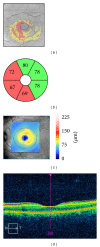Comparative diagnostic accuracy of ganglion cell-inner plexiform and retinal nerve fiber layer thickness measures by Cirrus and Spectralis optical coherence tomography in relapsing-remitting multiple sclerosis
- PMID: 25313352
- PMCID: PMC4182893
- DOI: 10.1155/2014/128517
Comparative diagnostic accuracy of ganglion cell-inner plexiform and retinal nerve fiber layer thickness measures by Cirrus and Spectralis optical coherence tomography in relapsing-remitting multiple sclerosis
Abstract
Objective: To estimate sensitivity and specificity of several optical coherence tomography (OCT) measurements for detecting retinal thickness changes in patients with relapsing-remitting multiple sclerosis (RRMS), such as macular ganglion cell-inner plexiform layer (GCIPL) thickness measured with Cirrus (OCT) and peripapillary retinal nerve fiber layer (pRNFL) thickness measured with Cirrus and Spectralis OCT.
Methods: Seventy patients (140 eyes) with RRMS and seventy matched healthy subjects underwent pRNFL and GCIPL thickness analysis using Cirrus OCT and pRNFL using Spectralis OCT. A prospective, cross-sectional evaluation of sensitivities and specificities was performed using latent class analysis due to the absence of a gold standard.
Results: GCIPL measures had higher sensitivity and specificity than temporal pRNFL measures obtained with both OCT devices. Average GCIPL thickness was significantly more sensitive than temporal pRNFL by Cirrus (96.34% versus 58.41%) and minimum GCIPL thickness was significantly more sensitive than temporal pRNFL by Spectralis (96.41% versus 69.69%). Generalised estimating equation analysis revealed that age (P = 0.030), optic neuritis antecedent (P = 0.001), and disease duration (P = 0.002) were significantly associated with abnormal results in average GCIPL thickness.
Conclusion: Average and minimum GCIPL measurements had significantly better sensitivity to detect retinal thickness changes in RRMS than temporal pRNFL thickness measured by Cirrus and Spectralis OCT, respectively.
Figures


Similar articles
-
Normative Data and Conversion Equation for Spectral-Domain Optical Coherence Tomography in an International Healthy Control Cohort.J Neuroophthalmol. 2022 Dec 1;42(4):442-453. doi: 10.1097/WNO.0000000000001717. Epub 2022 Oct 18. J Neuroophthalmol. 2022. PMID: 36049213 Free PMC article.
-
Color-code agreement among stratus, cirrus, and spectralis optical coherence tomography in relapsing-remitting multiple sclerosis with and without prior optic neuritis.Am J Ophthalmol. 2013 May;155(5):890-7. doi: 10.1016/j.ajo.2012.11.025. Epub 2013 Feb 8. Am J Ophthalmol. 2013. PMID: 23398979
-
Comparative study of macular ganglion cell-inner plexiform layer and peripapillary retinal nerve fiber layer measurement: structure-function analysis.Invest Ophthalmol Vis Sci. 2013 Nov 8;54(12):7344-53. doi: 10.1167/iovs.13-12667. Invest Ophthalmol Vis Sci. 2013. PMID: 24130187
-
Retinal Neurodegeneration in Diabetic Peripheral Neuropathy by Optical Coherence Tomography: A Systematic Review and Meta-analysis.Curr Eye Res. 2021 Aug;46(8):1201-1208. doi: 10.1080/02713683.2021.1874025. Epub 2021 Feb 2. Curr Eye Res. 2021. PMID: 33428500
-
Optical coherence tomography as a prognostic tool for disability progression in MS: a systematic review.J Neurol. 2023 Feb;270(2):1178-1186. doi: 10.1007/s00415-022-11474-4. Epub 2022 Nov 13. J Neurol. 2023. PMID: 36372866
Cited by
-
The retinal ganglion cell layer predicts normal-appearing white matter tract integrity in multiple sclerosis: A combined diffusion tensor imaging and optical coherence tomography approach.Hum Brain Mapp. 2018 Apr;39(4):1712-1720. doi: 10.1002/hbm.23946. Epub 2018 Jan 15. Hum Brain Mapp. 2018. PMID: 29334156 Free PMC article.
-
Retinal layers and associated clinical factors in schizophrenia spectrum disorders: a systematic review and meta-analysis.Mol Psychiatry. 2022 Sep;27(9):3592-3616. doi: 10.1038/s41380-022-01591-x. Epub 2022 May 2. Mol Psychiatry. 2022. PMID: 35501407
-
Ability of Swept-Source Optical Coherence Tomography to Detect Retinal and Choroidal Changes in Patients with Multiple Sclerosis.J Ophthalmol. 2018 Nov 13;2018:7361212. doi: 10.1155/2018/7361212. eCollection 2018. J Ophthalmol. 2018. PMID: 30538857 Free PMC article.
-
Multifocal visual evoked potentials and contrast sensitivity correlate with ganglion cell-inner plexiform layer thickness in multiple sclerosis.Clin Neurophysiol. 2019 Jan;130(1):180-188. doi: 10.1016/j.clinph.2018.10.007. Epub 2018 Nov 13. Clin Neurophysiol. 2019. PMID: 30473445 Free PMC article.
-
Unraveling the inflammation-degeneration tangle in early MS: preliminary insights from ferritin, neurogranin, TREM2, and retinal ganglion cell layer.J Neurol. 2025 Jan 15;272(2):109. doi: 10.1007/s00415-024-12797-0. J Neurol. 2025. PMID: 39812684 Free PMC article.
References
-
- Ojeda E, Díaz-Cortes D, Rosales D, Duarte-Rey C, Anaya J-M, Rojas-Villarraga A. Prevalence and clinical features of multiple sclerosis in Latin America. Clinical Neurology and Neurosurgery. 2013;115(4):381–387. - PubMed
-
- Ikuta F, Zimmerman HM. Distribution of plaques in seventy autopsy cases of multiple sclerosis in the United States. Neurology. 1976;26(6) part 2:26–28. - PubMed
-
- Rebolleda G, González-López JJ, Muñoz-Negrete FJ, Oblanca N, Costa-Frossard L, Álvarez-Cermeño JC. Color-code agreement among stratus, cirrus, and spectralis optical coherence tomography in relapsing-remitting multiple sclerosis with and without prior optic neuritis. The American Journal of Ophthalmology. 2013;155(5):890–897. - PubMed
Publication types
MeSH terms
LinkOut - more resources
Full Text Sources
Other Literature Sources

